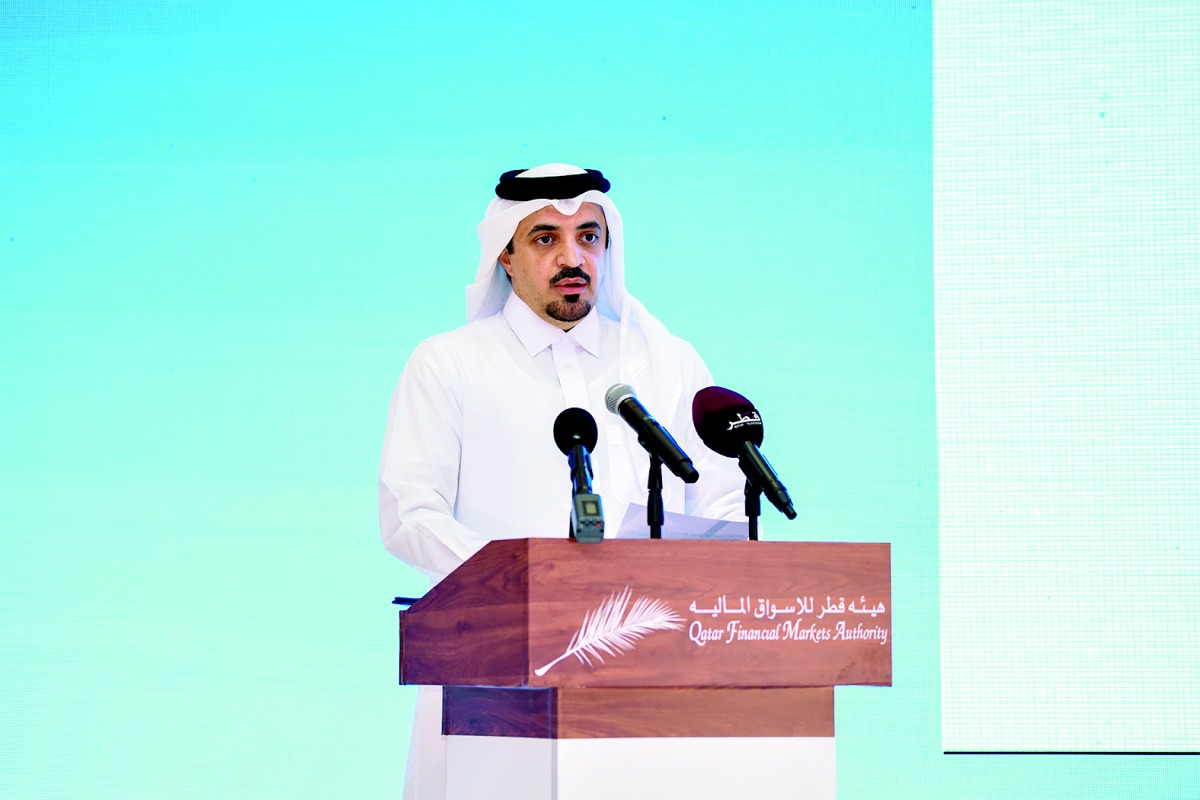QFMA Launches Its 2023-2027 3rd Strategic Plan
هيئة قطر للأسواق المالية تدشن خطتها الاستراتيجية الثالثة
QNA
Doha: HE Governor of Qatar Central Bank (QCB) and Chairman of the Board of Directors of Qatar Financial Markets Authority (QFMA) Sheikh Bandar bin Mohammed bin Saoud Al-Thani launched on Thursday the 2023-2027 QFMA 3rd Strategic Plan, in the presence of a number of members of the QFMA’s Board of Directors and CEO of QFMA Dr. Tamy bin Ahmad Al Binali, as well as the QFMA’s leaders and department directors.
Dr. Al Binali said that QFMA’s new strategic plan is based on the Qatar National Vision 2030 and the 3rd Qatar National Development Strategy (QNDS), with strategic domains: Fiscal Stability and Sustainability Financial System Stability and Economic Resilience, in addition to the 3rd Qatar Financial Sector Strategy (FSS), with strategic dimensions: Governance and Regulatory Oversight, Islamic Finance, Digital Innovation and Advanced Technology, Institutional Governance for Environmental and Social and Sustainability (ESG) and Talents and Competencies.
Dr. Al Binali added that the new QFMA strategic plan also has considered QFMA LAW, Vision, and Mission, Qatar Economic Outlook inclusive of GCC, Benchmarking Study of Capital Market Regulators Strategic Plans, Review of Global Capital Market Regulators, Review of Qatar CM Sector & EAP for Capital Development Projects, Review of QCB FinTech Strategy, and the IOSCO Principles and FATF 2023 Qatar Observations.
By adopting the 3rd Qatar Financial Sector Strategy (FSS), QFMA is working to achieve the desired transformation in the Qatari capital market sector, as the future vision related to the capital market within the plan aims to achieve an enhanced regulatory framework aligned with leading international standards, including robust regulation on investor protection, market transparency, and corporate governance, and the achievement of a State-of-the-art capital markets infrastructure, including electronic trading platforms and cloud computing facilities, ensuring data accessibility, and moving the market from emerging to developed market status.
Dr. Al Binali pointed out that the vision of the Qatar Financial Markets Authority in accordance with the new strategy is to advance the Qatari capital market to the “Developed” status, which represents one of the main pillars of the national economy, explaining that the QFMA’s mission according to the strategy as well, also includes the development and regulation of financial markets that are fair and transparent to ensure the protection of their participants, based on high-level legislative standards and sustainability practices by strengthening the technological infrastructure and human capital with diverse competencies, and raising the awareness of market participants.
As for the QFMAs strategic objectives, they include six objectives: Enabling future-proof legislations, Developing sustainable capital markets, Accelerating Digital and Innovative Advancements, Advancing financial awareness and market participation, Enhancing local and international cooperation, and Attracting talents and building capabilities.
Dr. Al Binali spoke about the details of these objectives in terms of initiatives related to each of them, where he explained that the first strategic objective includes initiatives to determine the legal and regulatory changes in the State (QFMA law, QCB law etc ) to support enhancement of capital market, implementing Governance Codes for Financial Services Companies, Companies Listed on the Main Market and Second market, Listed Funds and Entities subject to the Authority’s supervision, developing a Framework for Fixed-Income Markets and for Asset Management as well for Islamic Finance related to Capital Market, developing targeted regulations for Green Assets and initiative for developing Solvency Standards.
The first objective initiatives also include updating AML/CFT rules related to account opening and VA & VASPs and emerging risks, setting and issuing regulations for the private companies’ market, updating the codes of external auditors and financial evaluators of listed entities and audited entities, enhancing the code of conduct for employees in the trading sector (licensees and listed companies’ employees), developing standards for financial evaluation, research and dissemination of information related to the market and securities 2022, developing legal/regulatory framework for digital assets and smart contracts.
The second strategic objective includes initiatives to rebrand the corporate identity of the QFMA to reflect on the strategy and sustainable markets, develop an environmental-friendly new headquarters for QFMA, enhance the Risk-Based Supervision Model, establish a Risk Insurance Fund in accordance with Article 53 of Law No. (8) of 2012 regarding the Qatar Financial Markets Authority.
Dr. Al Binali said that the initiatives of the third strategic objective are to develop and execute the Digital Transformation Strategy, adopt the QFC Model in the digital/virtual marketplace (3rd FSS) and consider future implementation, considering Robotic Advisory for Asset Management, and support the creation and innovation of the private companies’ market.
With regard to the fourth strategic objective, he explained that the initiatives of this objective include spreading financial awareness and culture & organizing international specialized seminars – for investors and dealers in the financial markets and those interested, introducing Research Papers, introducing the basics of investment and investor protection to school and university students at international financial events, developing programmes on the importance of investment in the bond market, enhancing knowledge in Islamic Finance, Asset Management and ESG, introducing the concepts of Digital/Virtual products and services, and increasing Financial Inclusion Initiatives.
The initiatives of the fifth strategic objective include establishing strategic cooperation with local regulators and other local government entities, activating channels of collaboration through memorandums of understanding and cooperation with regional and international organizations, increasing coordination and cooperation with counterparts in the GCC countries, raising the level of participation and hosting of conferences and meetings, starting the process of becoming a signatory to the IOSCO EMMoU, entering into MoUs and Cooperation agreements with well-established international Fintech and Asset Management hubs, and creating an international resources and research library.
Dr. Al Binali continued by saying that the initiatives of the sixth strategic objective include supporting and investing in the Qatarization Plan (Recruitment and Talent Acquisition) and maintaining an acceptable turnover ratio, developing the digital accelerators’ programmes for locals, adopting and executing specialized programmes for leadership development, and developing and enhancing the performance management framework and the remuneration structure of QFMA.
QFMA’s strategic plan includes a set of digital transformation initiatives, particularly, revamping the QFMA’s website, creating an intranet portal, enriching the e-learning portal, establishing a framework for IT governance, establishing an advisory board to guide change initiatives, establishing a project management system, an inspection system and another for insider information tracking, moving to cloud computing and artificial intelligence in social media for disclosure, developing a regulatory technology strategy and developing guidelines and implementation of the Qatar’s National Cybersecurity Framework.
قنا
الدوحة: دشن سعادة الشيخ بندر بن محمد بن سعود آل ثاني، محافظ مصرف قطر المركزي ورئيس مجلس إدارة هيئة قطر للأسواق المالية، اليوم الخطة الاستراتيجية الثالثة للهيئة للأعوام 2023 ــ 2027، بحضور عدد من أعضاء مجلس إدارة هيئة قطر للأسواق المالية، والدكتور طامي بن أحمد البنعلي، الرئيس التنفيذي للهيئة، إضافة إلى قيادات الهيئة ومديري الإدارات.
وقال الدكتور البنعلي، إن الخطة الاستراتيجية الجديدة للهيئة، تستند إلى رؤية قطر الوطنية 2030، واستراتيجية التنمية الوطنية الثالثة لدولة قطر، والتي تشتمل على مجالات الاستقرار المالي والاستدامة، واستقرار النظام المالي، والمرونة الاقتصادية، إضافة إلى الاستراتيجية الثالثة لتنظيم القطاع المالي في قطر، والتي تشتمل على الأبعاد الاستراتيجية المتعلقة بالحوكمة والرقابة التنظيمية، التمويل الإسلامي، والتحديث في المجالات الرقمية وتبني التكنولوجيات المتطورة، وقياس الاستدامة المؤسسية من خلال الأطر البينية والاجتماعية وإطار الحوكمة، واستقطاب المواهب والكفاءات.
وأضاف الدكتور البنعلي أن الخطة الاستراتيجية الجديدة للهيئة، أخذت بعين الاعتبار كذلك، قانون هيئة قطر للأسواق المالية ورؤيتها ورسالتها، وتطلعات قطر الاستراتيجية التي تشمل دول مجلس التعاون الخليجي، ودراسة معيارية للمقاربة مع الخطط الاستراتيجية لدى الجهات التنظيمية للأسواق الرأسمالية الأخرى، ومراجعة ما هو معتمد لدى منظمي سوق رأس المال العالمي، ومراجعة قطاع CM في قطر وخطة العمل التنفيذية لأغراض مشاريع التطوير الرأسمالي، ومراجعة استراتيجية التكنولوجيا المالية المعتمدة لدى مصرف قطر المركزي، ومبادئ المنظمة الدولية لهيئات الأوراق المالية (IOSCO) وملاحظات مجموعة العمل المالي (فاتف) لعام 2023 بخصوص قطر.
ومن خلال تبني الخطة الاستراتيجية الثالثة للقطاع المالي، تعمل هيئة قطر للأسواق المالية على تحقيق التحول المنشود في قطاع سوق رأس المال القطري، حيث تهدف الرؤية المستقبلية المتعلقة بسوق رأس المال ضمن الخطة، إلى تحقيق إطار عمل تنظيمي محسن ومتوائم مع المعايير الدولية الرائدة، ويشمل ذلك تطبيق قواعد تنظيمية صارمة لضمان حماية المستثمرين، وشفافية السوق، وحوكمة الشركات، وتحقيق بنية تحتية للأسواق الرأسمالية مبنية على أحدث التكنولوجيات في المجال، وتشمل منصات التداول الإلكترونية، ومرافق الحوسبة السحابية، وضمان إمكانية الوصول إلى البيانات بكفاءة، إضافة إلى الارتقاء بسوق رأس المال من مرتبة سوق ناشئة إلى سوق متقدمة.
وأشار الدكتور البنعلي إلى أن رؤية هيئة قطر للأسواق المالية وفقا للاستراتيجية الجديدة، تتمثل في الارتقاء بسوق رأس المال القطري لتصنيف “متقدم”، وهو ما يمثل إحدى الركائز الأساسية للاقتصاد الوطني، موضحا أن مهمة الهيئة وفقا للاستراتيجية كذلك، تشمل أيضا تطوير وتنظيم أسواق مالية تتسم بالعدالة والشفافية لضمان حماية المشاركين فيها، مبنية على معايير تشريعية وممارسات استدامة عالية المستوى من خلال تعزيز البنية التحتية التكنولوجية ورأسمال بشري ذي كفاءات متنوعة، ورفع مستوى وعي المشاركين في السوق.
أما بشأن الأهداف الاستراتيجية للهيئة، فتشمل ستة أهداف هي: سن التشريعات المرنة لاستيعاب التغيرات المستقبلية، تطوير أسواق رأسمالية قابلة للاستدامة، تسريع تبني المستجدات التكنولوجية والرقمية، التأكيد على أهمية الوعي المالي والمشاركة في السوق، تعزيز التعاون المحلي والدولي، واستقطاب المواهب وبناء القدرات.
وتحدث الدكتور البنعلي عن تفاصيل هذه الأهداف من حيث المبادرات المتعلقة بكل منها، مبينا أن الهدف الاستراتيجي الأول يشمل مبادرات تحديد التغييرات القانونية والتنظيمية التي أدخلتها الدولة لدعم سوق رأس المال مثل قانون هيئة قطر للأسواق المالية، وقانون مصرف قطر المركزي، وتنفيذ نظام الحوكمة لشركات الخدمات المالية، والشركات المدرجة في السوق الرئيسية والسوق الثانية، والصناديق المدرجة والمؤسسات الخاضعة لرقابة الهيئة، وتطوير إطار عمل لأسواق الدخل الثابت وإدارة الأصول والتمويل الإسلامي المتعلق بسوق رأس المال، ووضع لوائح تستهدف الأصول الخضراء، ومبادرة تطوير معايير الملاءة المالية.
كما تشمل مبادرات الهدف الأول، تحديث قواعد مكافحة عمليات غسل الأموال وتمويل الإرهاب المتعلقة بفتح الحسابات، والأصول الافتراضية ومزودي خدمات الأصول الافتراضية، والحد من المخاطر الناشئة عن كل ذلك، ووضع اللوائح المنظمة لسوق الشركات الخاصة وإصدارها، وتحديث القواعد التي تحكم عمل المدققين الخارجيين والمقيمين الماليين للكيانات المدرجة والكيانات الخاضعة للتدقيق، وتعزيز قواعد السلوك للعاملين في قطاع التداول (الأفراد المرخصين وموظفي الشركات المدرجة)، وتطوير معايير التقييم المالي والبحث ونشر المعلومات المتعلقة بالسوق والأوراق المالية للعام 2022، إضافة إلى تطوير الإطار القانوني/ التنظيمي للأصول الرقمية والعقود الذكية.
وأشار الدكتور البنعلي إلى أن الهدف الاستراتيجي الثاني، يشمل مبادرات إعادة تصميم الهوية المؤسسية لهيئة قطر للأسواق المالية لتعكس الاستراتيجية والأسواق المستدامة، وتطوير مقر رئيسي جديد صديق للبيئة لهيئة قطر للأسواق المالية، وتحسين نموذج الإشراف القائم على تقييم المخاطر، وإنشاء صندوق للتأمين ضد المخاطر وفقا للمادة 53 من القانون رقم (8) لسنة 2012 بشأن هيئة قطر للأسواق المالية.
وقال الدكتور البنعلي إن مبادرات الهدف الاستراتيجي الثالث، تتمثل في تطوير استراتيجية التحول الرقمي وتنفيذها، واعتماد نموذج مركز قطر للمال فيما يخص السوق الرقمية/ الافتراضية (استراتيجية القطاع المالي الثالثة) والنظر في تطبيقه مستقبلا، والنظر في الاستشارات الروبوتية لإدارة الأصول، ودعم إنشاء سوق الشركات الخاصة وتطويرها بشكل مبتكر.
وفيما يتعلق بالهدف الاستراتيجي الرابع، أوضح الدكتور البنعلي أن مبادرات هذا الهدف تشمل، نشر الوعي والثقافة المالية وتنظيم ندوات دولية متخصصة للمستثمرين والمتعاملين في الأسواق المالية وللمهتمين، وتقديم الأوراق البحثية، وتقديم أساسيات الاستثمار وحماية المستثمر لطلاب المدارس والجامعات في الفعاليات المالية الدولية، وتنظيم برامج عن أهمية الاستثمار في سوق السندات، وتعزيز المعرفة في التمويل الإسلامي وإدارة الأصول والحوكمة البيئية والاجتماعية وحوكمة الشركات، وإدخال مفاهيم المنتجات والخدمات الرقمية/ الافتراضية، وزيادة مبادرات الشمول المالي.
أما مبادرات الهدف الاستراتيجي الخامس، فتشمل وفقا للدكتور البنعلي، إقامة تحالفات استراتيجية والتعاون مع الجهات التنظيمية المحلية والكيانات الحكومية المحلية الأخرى، وتفعيل قنوات التعاون الدولي من خلال مذكرات التفاهم والتعاون مع المنظمات الإقليمية والدولية، وزيادة التنسيق والتعاون مع دول مجلس التعاون الخليجي، ورفع مستوى المشاركة في المؤتمرات والاجتماعات واستضافتها، وبدء عملية الانضمام لمذكرة التفاهم متعددة الأطراف المحسنة (EMMoU) لدى المنظمة الدولية لهيئات الأوراق المالية (IOSCO) كجهة مخولة بالتوقيع، والدخول في مذكرات تفاهم واتفاقيات تعاون مع مراكز دولية معروفة للتكنولوجيا المالية ومراكز دولية معروفة لإدارة الأصول، وإنشاء مكتبة مصادر وأبحاث دولية.
وتابع الدكتور البنعلي قوله، إن مبادرات الهدف الاستراتيجي السادس، تشمل دعم خطة التقطير والاستثمار فيها (التوظيف واستقطاب المواهب) والحفاظ على نسبة مقبولة لدوران الموظفين، وتطوير البرامج الهادفة إلى إدخال أحدث التكنولوجيات الرقمية في أسرع وقت لصالح السكان المحليين، واعتماد البرامج المخصصة لتنمية المهارات القيادية وتنفيذها، وتطوير إطار العمل الخاص بإدارة الأداء وهيكل الأجور والمكافآت لدى هيئة قطر للأسواق المالية وتحسينهما.
وتتضمن الخطة الاستراتيجية لهيئة قطر للأسواق المالية، مجموعة مبادرات للتحول الرقمي من أهمها إعادة بناء الموقع الإلكتروني للهيئة وتجديده، واستحداث شبكة “انترنت” داخلية في الهيئة، وإغناء بوابة التعلم الإلكتروني، وإنشاء إطار عمل لحوكمة نظم المعلومات، وإنشاء مجلس استشاري لتوجيه مبادرات التغيير، وإنشاء نظام لإدارة المشاريع ونظام للتفتيش وآخر لتتبع المعلومات من الداخل، والانتقال إلى الحوسبة السحابية والذكاء الاصطناعي في وسائل التواصل الاجتماعي للإفصاح، ووضع استراتيجية تنظيمية للتكنولوجيا وإعداد الإرشادات الخاصة بها، وتطبيق إطار العمل الوطني للأمن السيبراني في دولة قطر.




